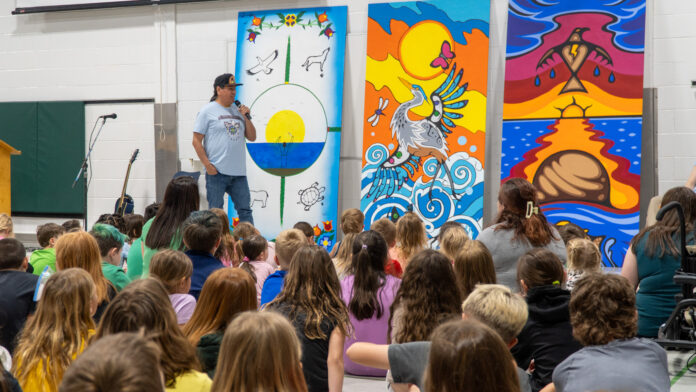A spirit of celebration, culture, and connection filled three St. Clair Catholic elementary schools in Wallaceburg on May 12, as students, families, artists, and community members gathered to unveil new Indigenous art installations—powerful visual statements of identity, representation, and reconciliation.
Holy Family, Christ the King, and St. Elizabeth Catholic Schools each hosted heartfelt ceremonies that featured opening songs, prayer in Anishinaabemowin, and reflections from the three Anishinaabe artists who co-created the works: Cedric Isaac of Bkejwanong Territory, John Williams of Aamjiwnaang First Nation, and Moses Lunham of Kettle and Stony Point First Nation.
Created in collaboration with students from Kindergarten through Grade 8, the installations are rich with symbolism and story, each one reflecting a theme deeply rooted in local Anishinaabe teachings and tailored to the unique spirit of each school community. Through colour, line, and narrative, the artists worked alongside students to bring these visions to life—honouring Indigenous knowledge and perspectives while fostering meaningful learning.
“These art pieces are stunning,” said Lisa Demers, Director of Education. “But even more than that, they are a lasting visual reminder and learning opportunity—for generations to come—of what it means to walk alongside Indigenous communities in truth, learning, and celebration.”
The unveiling events also included short documentary videos capturing the creative process, offering students and guests a rare behind-the-scenes look at how the murals were shaped from initial ideas into vibrant public art.
Live music from Nolan Wilde of Brothers Wilde (Kettle and Stony Point First Nation) and artist Cedric Isaac brought energy and celebration to each gathering, reinforcing the importance of culture, creativity, and collaboration in building community.
“These installations are more than just paint on panels,” said Cortnee Goure, Indigenous Education Lead for St. Clair Catholic. “They’re a living experience. They carry the voices of students, a collaboration across communities, and a connection to the land and all of Creation.”
The events marked a continued commitment by the Board to Indigenous education and relationship-building, with local knowledge carriers and elders engaged from planning through to the final reveal.
All three art pieces will remain permanent fixtures in their respective schools—a proud and enduring symbol of learning, respect, and community for years to come.
















